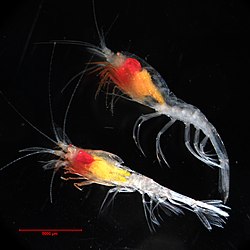| Oplophoridae | |
|---|---|
 | |
| Hymenodora glacialis | |
| Scientific classification | |
| Kingdom: | Animalia |
| Phylum: | Arthropoda |
| Class: | Malacostraca |
| Order: | Decapoda |
| Suborder: | Pleocyemata |
| Infraorder: | Caridea |
| Superfamily: | Oplophoroidea Dana, 1852 |
| Family: | Oplophoridae Dana, 1852 |
The family Oplophoridae is a taxon of pelagic shrimp and the only subtaxon of the superfamily Oplophoroidea. [1] It contains the following genera: [1]
- Acanthephyra A. Milne-Edwards, 1881
- Ephyrina Smith, 1885
- Heterogenys Chace, 1986
- Hymenodora Sars, 1877
- Janicella Chace, 1986
- Kemphyra Chace, 1986
- Meningodora Smith, 1882
- Notostomus A. Milne-Edwards, 1881
- † Odontochelion Garassino, 1994
- Oplophorus H. Milne-Edwards, 1837
- Systellaspis Bate, 1888
- † Tonellocaris Garassino, 1998
Molecular phylogenetics suggests that the family as currently circumscribed is polyphyletic, and may lead to the resurrection of a family Acanthephyridae for all genera except Oplophorus, Systellaspis and Janicella. [2]